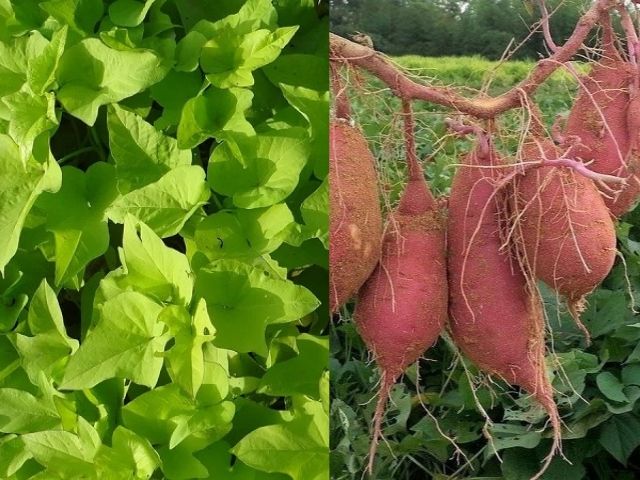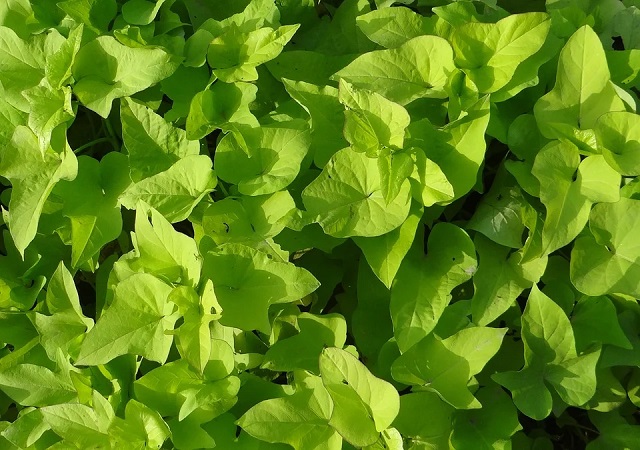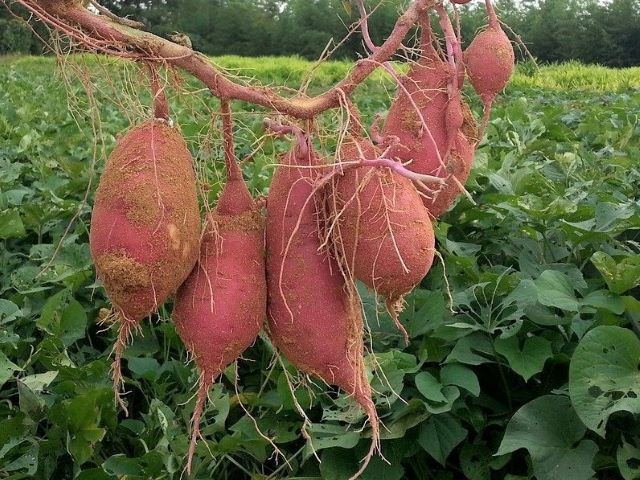Sweet potatoes are a beloved crop so when sweet potato leaves turn yellow, you’ll want to know why and how to fix it. In this article, we explore the reasons your sweet potato plant’s leaves are turning yellow and what you can do about them to restore your plant to full health.

Yellowing leaves on sweet potatoes is a common problem for sweet potatoes. And if you look carefully at the plant and its conditions, you’ll likely be able to get to the root of the problem.
Reasons why sweet potato leaves are turning yellow include watering issues, poor growing conditions, nutrient deficiencies, fungal diseases and pests.
Let’s look into each of these problems in more detail and how to solve them.
Table of Contents
Watering Issues Cause Sweet Potato Leaves To Yellow
One of the first things you should consider when your sweet potato leaves turn yellow is watering. Are your sweet potato vines getting the right amount of water?
During the growing season, provided they’re in the right temperatures (more on that later), sweet potato vines should be watered enough that the soil remains consistently moist. While most sweet potato plants are tolerant of droughts, they will do better with more consistent watering.
If you stick your finger all the way into the soil and it’s dry, it’s time to water your sweet potatoes. If they get too dry, especially in high temperatures, sweet potato leaves will start to wilt and turn yellow.
On the other hand, it is possible to over-water sweet potatoes. This usually leads to root rot. While the soil should be consistently moist, you don’t want it to be waterlogged either. When it comes to sweet potatoes, it’s probably safer to slightly underwater than to over-water.
If your sweet potato leaves are yellowing because they’re overwatered, and possibly have root rot, you should let the soil dry out a bit. Root rot appears by making the roots of the plants black and soft. Often, root rot is difficult to treat for in-ground plants. Avoid overwatering, and let the sweet potato vines dry out a bit if you need to.

Poor Growing Conditions Cause Sweet Potato Leaves To Turn Yellow
After looking at watering, you should think about the general growing conditions for your sweet potato vines. Any issue with their environment or conditions can very easily cause yellowing leaves.
First, sweet potatoes should have well-draining soil. They don’t like to sit in excess water, so a heavier soil will only weigh down the roots and possibly lead to growing problems.
Additionally, sweet potato plants like to get fair amounts of sunlight, but not be too hot. Often, they grow well in partial shade, and can sometimes grow in full shade. If you get a lot of hot days, it’s best to ensure that your sweet potato plants have decent shade to protect their leaves.
In terms of climate, sweet potatoes can live in a large range. However, they grow best in a temperature between 75-95 °F (24-35 °C).
They can survive in lower temps, as long as the soil doesn’t drop below 55 °F (13 °C).
And sweet potato plants are drought-tolerant, so they can handle more heat if necessary. They tend to thrive more in humid climates though: a lot of hot, dry air isn’t going to create the best environment for them.
So if your sweet potato vine leaves are yellowing, take some time to assess their environment and growing conditions.
Nutrient Deficiencies Cause Sweet Potato Leaves To Turn Yellow
Sweet potatoes often grow large and fast, and indeed, many gardeners find that they have to cut the plants back. But they’ll only grow like this with the proper soil nutrients. Without those, the plants will be smaller and the leaves can start to yellow.
Regularly applying organic fertilizer is a great way to promote healthy sweet potato growth.
The two most common nutrient deficiencies are nitrogen and magnesium.
If your soil is lacking in nitrogen, you can add an organic nitrogen-righ fertilizer such as this one, to provide your sweet potato vines with a boost. This will encourage growth and get your sweet potatoes back to full health.
For magnesium deficiencies, all you really need is general fertilizer. This means that homemade organic compost will be ideal! Compost is rich in magnesium and will help get your sweet potato vine leaves back on track.
Sweet Potato Plant Diseases Cause Leaves To Turn Yellow
Sweet potatoes can be affected by diseases, primarily fungal ones. When planting sweet potatoes, it helps to find varieties that are resistant to disease.
Some good disease-resistant varieties of sweet potatoes include Bayou Belle, Beauregard “B-63”, Evangeline sweet potato, and Murasaki-29.
Additionally, fungal diseases can be hard to treat. Sometimes, the best you can do is to remove the infected areas and protect the rest of the plants. If your sweet potato vine leaves catch a fungal disease, it’s a good idea to plant in a different area next year, as fungi can stay alive in the soil for a long time.
Here are the four most common fungal diseases that affect sweet potato plants, what they look like, and what to do about them:
- Wilt: This is often causes by the fungus verticillium or fusarium. It will start as yellowing at the base of the sweet potato plant, and work its way up. The best thing to do is remove infected plants, rotate your planting zones, and try to avoid letting the fungus come in contact with other plants.
- Black root: This fungus causes plants to wilt, and affects all parts of the plant. Even if the tubers look healthy, they can still be infected for a long time. If you notice this, it’s best to remove the infection, don’t keep the tubers, and rotate planting zones. And remember, buying disease-resistant varieties can really help.
- Alternaria: Also called leaf spot and stem blight, this fungus causes black spots on leaves and stems surrounded by yellow patches. Sometimes, the plant can still grow, and the tubers will be ok. Buy disease-resistant varieties, and be sure to clear away all parts of the plant after harvesting. Consider planting in a different plot for a couple years.
- Leaf and stem scab: This also causes spots on leaves and stems, but they are often a deep purple-brown. It occurs more frequently in areas with a lot of fog, rain, or dew. Try to water only the base of the plant, and remove the infected areas.
Sweet Potato Vine Pests Cause Leaves To Turn Yellow
Lastly, pests can be a detriment to sweet potatoes and cause their leaves to turn yellow. Luckily, there aren’t many common pests, but there are a couple to watch out for.
If you notice holes in your sweet potato leaves, you likely have a problem with beetles. Shaking beetles off into buckets of soapy water or spraying the plants with horticultural neem oil such as this one, can control beetles. You can also add diatomaceous earth to your soil, which will kill off the beetles.
Aphids are the other main pest to look out for. Sweet potato leaves will start to wilt and rot. Twisted and curled leaves and stunted growth are good signs you’re dealing with aphids.
A blast of water on the leaves can dislodge the aphids from the sweet potato leaves. And again, neem oil can help get rid of aphids. And finally encouraging helpful bugs, like ladybugs who fed of aphids, will keep any aphid infestation at bay.

Further Reading:
- How to Start Sweet Potato Slips for Growing Sweet Potatoes (With Photos)
- Eating Sweet Potato Leaves with Recipe Ideas
- Can You Plant Sprouted Potatoes? (And How!)
- 7 Pests That Eat Potato Leaves And How To Get Rid Of Them
- 7 Reasons Potato Plants Are Dying
- Beet Leaves Turning Yellow? Causes and Solutions
- The Best Raised Garden Beds
- Turnips Vs Radishes: What’s The Difference?
- Zucchini Leaves Turning Yellow: Causes and Solutions
